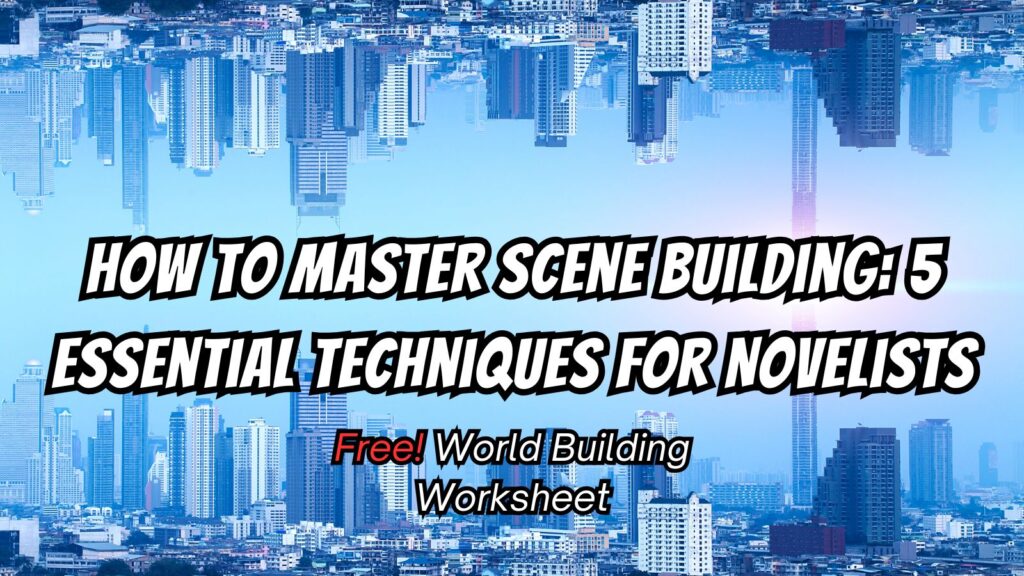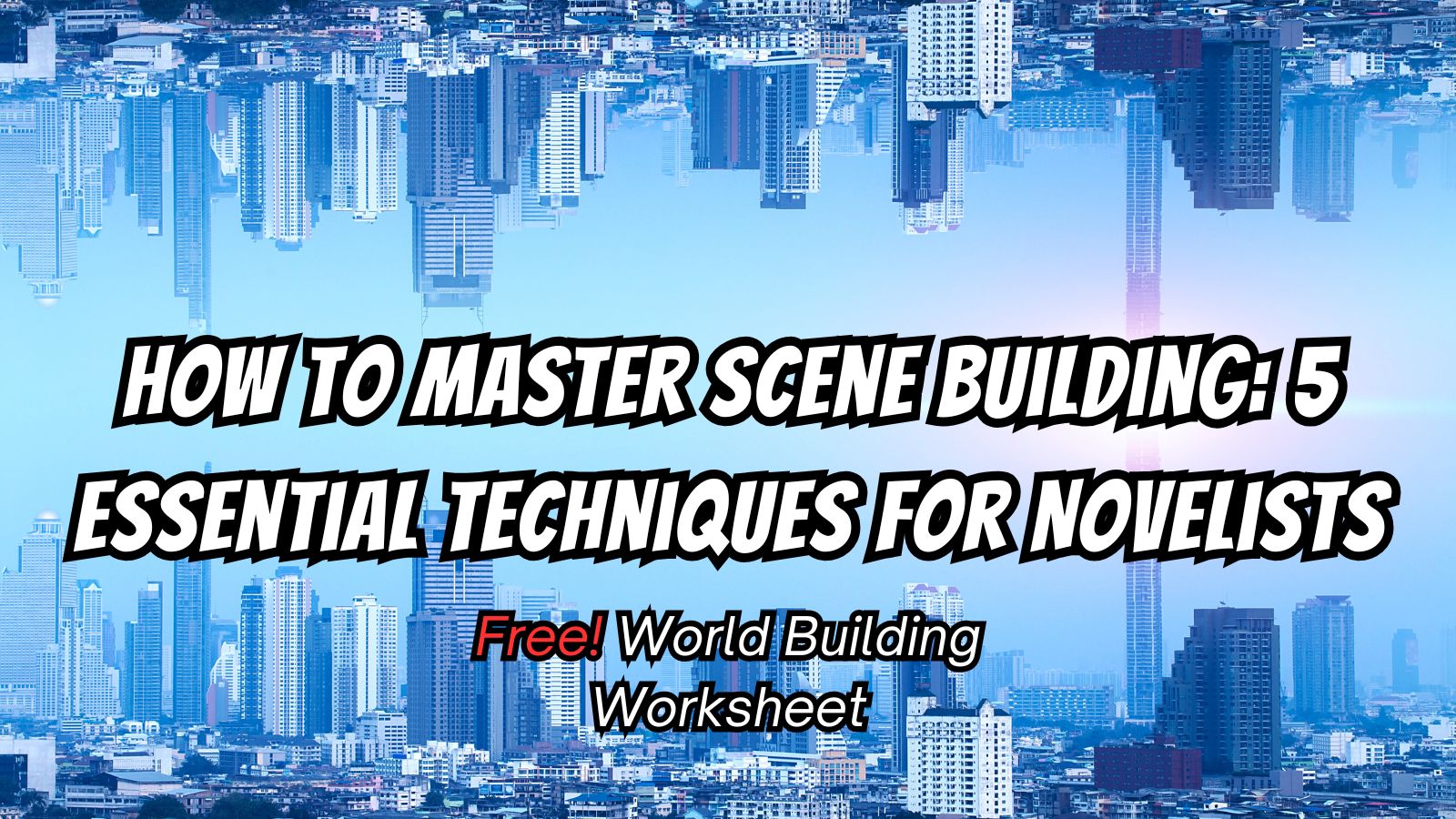
How to Master Scene Building: 5 Essential Techniques for Novelists
What’s the secret ingredient that makes readers stay up until 3 AM, frantically turning pages?
Why, perfectly crafted scenes, of course!
When I wrote my first novel, I thought brilliant characters and clever plot twists were enough. I spent weeks meticulously outlining my plot and developing character backstories—yet my early drafts still fell flat. My beta readers would say things like, “I’m just not feeling it” or “I got lost in this part.”
Sound familiar? If you’ve ever struggled with scenes that fall flat, you’re in the right place.
Why Strong Scene Structure Is Essential for a Great Novel
Think of your novel as a beautiful historic home. Your plot is the foundation, your characters are the inhabitants, but your scenes? Those are the actual rooms where readers will spend their time.
You can have the most ingenious plot outline and the most compelling characters ever created, but if your scenes don’t deliver, readers will put your book down faster than a hot potato.
Great scenes aren’t just about what happens. They’re about immersion—making readers feel as though they’re right there alongside your characters, experiencing every triumph, setback, and revelation.
Some of my favorite books—like Gillian Flynn’s “Gone Girl” or Andy Weir’s “The Martian”—succeed largely because every scene serves multiple purposes while feeling effortlessly natural.
The 5 Essential Techniques for Writing Compelling Scenes
Want to know what separates amateur scene construction from professional-level writing? Here’s the secret sauce:
1. Define Clear Scene Purpose
Every scene needs a reason to exist. Full stop.
Ask yourself: “If I cut this scene entirely, would my story suffer?” If the answer is no, it’s time for some ruthless editing.
The best scenes accomplish multiple goals simultaneously. They might:
- Advance the plot
- Reveal character traits
- Establish crucial worldbuilding details
- Foreshadow coming events
- Create or resolve tension
Quick Check: Can you state your scene’s primary purpose in one sentence? If not, reconsider its role in your story.
2. Create Meaningful Character Development
Your characters should never be the same at the end of a scene as they were at the beginning. Something—even something subtle—should shift.
Maybe they:
- Learn new information
- Make an important decision
- Change their emotional state
- Discover something about themselves
- Alter their perception of another character
These micro-arcs within scenes create the satisfying character evolution that readers crave.
3. Incorporate Compelling Conflict
Without conflict, you don’t have a scene—you have exposition.
Conflict doesn’t always mean arguments or physical confrontations. It can be:
- Internal dilemmas
- Environmental obstacles
- Subtle interpersonal tensions
- Competing goals between allies
- Character vs. societal expectations
The key is ensuring your character wants something and something stands in their way.
4. Craft an Emotional Arc
The most memorable scenes take readers on an emotional journey. They might start with one feeling (dread, excitement, confusion) and end with another (relief, disappointment, clarity).
This emotional movement creates the page-turning quality we all want in our writing.
Ask yourself: What is the dominant emotion in this scene, and how does it shift by the end?
Example: In a scene where your protagonist meets her boyfriend’s parents, she might begin nervous (primary emotion), become briefly hopeful when they seem to like her, then end devastated when she overhears them criticizing her to their son.
When I’m stuck with a scene that isn’t working, I often realize it’s emotionally flat—maintaining the same note throughout instead of creating a compelling emotional progression.
5. Create Sensory Immersion
You’ve heard “show, don’t tell,” but great scenes go beyond visual details. They engage all five senses strategically.
- The smell of approaching rain before bad news arrives
- The gritty texture of sand between fingers during a difficult conversation
- The distant sound of children laughing that heightens a character’s sense of isolation
These sensory details don’t just describe a setting—they reinforce the emotional reality of the scene.
5 Common Scene-Building Mistakes to Avoid
After critiquing hundreds of manuscript pages (and cringing at my own early efforts), I’ve noticed these scene-killers appear again and again:
- The “So What?” Scene – Active but doesn’t change anything significant in character or plot
- The Info-Dump Scene – Uses dialogue or narrative primarily to deliver background information
- The Emotional Flatline – Maintains the same emotional temperature throughout
- The Transitional Time-Waster – Exists only to move characters from one location to another
- The Rushed Resolution – Builds beautiful tension but resolves too quickly
Does Your Scene Work? Check These 5 Boxes
- My scene has a clear purpose that advances the story
- At least one character experiences growth or change
- There’s meaningful conflict that creates tension
- The emotional tone shifts during the scene
- I’ve included strategic sensory details that enhance the mood
How to Self-Edit Your Scenes for Maximum Impact
Ready to transform your scenes from good to unforgettable? Here’s my battle-tested approach:
- Identify each scene’s primary purpose. Write it down in one sentence. If you can’t articulate it clearly, that’s your first red flag.
- Track the emotional trajectory. Note your viewpoint character’s emotional state at the beginning of the scene, then at the end. If they’re identical, revise.
- Highlight your sensory details. Are you engaging multiple senses? Are your sensory choices reinforcing the emotional tone of the scene?
- Examine your dialogue. Every line should reveal character, advance plot, create tension, or preferably some combination of these. Cut anything that doesn’t earn its keep.
- Check your pacing. Are you spending too many words on minor moments while rushing through crucial ones? The amount of text you devote to a moment should generally correspond to its importance.
Transform Your Scenes: Before & After Examples
Here’s a quick before-and-after glimpse of these principles in action:
Example 1: The Empty Action Scene
Before: Sarah entered the kitchen. It was messy. Dishes filled the sink. She sighed and started washing them, thinking about her argument with David earlier that day. When she finished, she dried her hands and left the room.
After: Sarah’s fingers tightened around the doorframe as she took in the kitchen disaster—David’s breakfast dishes still scattered across the counter twelve hours later. The sour-milk smell from the cereal bowl he’d abandoned made her stomach clench. She attacked the dishes, the scalding water turning her hands red as she scrubbed at a hardened egg yolk stain. “I’m not your maid,” she muttered, the words she should have said that morning instead of swallowing her resentment. Again.
Example 2: The Flat Dialogue Scene
Before: “We need to talk about what happened,” John said. “I don’t want to discuss it,” Maria replied. “But it’s important.” “Fine. What do you want to say?” “I think we should see other people.” “If that’s what you want.” “It is.” “Okay then.”
After: John blocked the doorway, arms crossed. “We need to talk about what happened.”
Maria kept folding laundry, matching socks with more focus than necessary. “Nothing happened.”
“Maria.” His voice softened. The same tone he’d used when her mother died. Her hands stilled.
“Don’t.” The word came out sharper than she’d intended.
He stepped closer, cologne mingling with the fabric softener scent. “I think we should—”
“See other people?” She finished, finally meeting his eyes. “Funny how you waited until after I paid off your credit card to decide that.”
His flinch was subtle but unmistakable. “It’s not about the money.”
She tossed him his neatly folded t-shirt. “It never is, until it is.”
See the difference? The second versions turn throwaway moments into scenes that reveal character dynamics, build tension, and advance emotional subplots.
“A great scene isn’t just what happens—it’s what changes. Make every scene count.” #WritingTips #SceneBuilding
Your Free Scene-Building Power Tool
If you’ve made it this far, you’re serious about leveling up your scene-writing skills. And I’ve got something special for you.
I’ve created a comprehensive Scene Builder Worksheet that incorporates all the principles we’ve discussed. This step-by-step template walks you through crafting powerful, purposeful scenes that keep readers engaged.
The worksheet covers:
- Scene basics and story function
- Character goals and emotional states
- Conflict types and tension sources
- Sensory details and atmosphere development
- Dialogue planning and turning points
- Setting integration
- Resolution types and transitions
It’s the same template I use for my own writing, and it’s transformed my storytelling process. No more meandering scenes or pointless interactions!
Click here to get your free Scene Builder Worksheet and start crafting unforgettable scenes today!
Related Articles:
- How to Write Dialogue That Captivates Your Reader
- Character Development: Creating Unforgettable Protagonists
- World-Building Techniques for Fiction Writers
The Scene-by-Scene Path to a Better Novel
Remember, masterful scene construction isn’t about natural talent—it’s about intentional practice and thoughtful planning.
Each scene is a promise to your reader. A promise that their time investment will reward them with meaningful character development, plot advancement, and emotional resonance.
With your Scene Builder Worksheet in hand, you now have a powerful tool to fulfill that promise consistently. Start using it on your current work-in-progress, and watch how quickly your storytelling transforms.
What’s your biggest struggle with scene building? Share your thoughts below, and let’s discuss!
Happy writing!
- When Edgar Allan Poe Fails the AI Detector - December 12, 2025
- THE MORAL GHOST STORY: Reviving a Lost Christmas Tradition - December 2, 2025
- The Last 6 Words of ’25: Holiday Memoir Contest - December 2, 2025

I’m glad to FINALLY be able to read this article. But why does the “Scene Builder Worksheet” link to a “World Building Questionnaire?” Scene-building and world-building are two VERY different things.
I’m so sorry! I linked to the wrong one, I’ll fix it! Try it again. I’m changing it now.
Hi again. That was six days ago. Now I’m blocked from seeing the Scene Builder Worksheet? I put in a request…
Does it come up with a screen to make a copy? I’m sorry you are having this issue. Right now it works through google drive, that way it makes it easy to use, but we are going to start putting up PDFs as well. I’ll try to have this resolved today. Please check back this evening or tomorrow. Again sorry, we are just getting the bugs worked out.
Hi Again,
To answer your question, I am unable to make a copy or even access the worksheet. I get an error screen: “Access Denied – You need access – Request access, or switch to an account with access.”
I’m really looking forward to this worksheet. Plotting and scene building are my weak points.
Thank you,
Debby
I’m so sorry. The google docs links are giving us a lot of problems. Here is the worksheet in pdf. https://www.everywritersresource.com/wp-content/uploads/2025/04/Scene-Builder-Worksheet.pdf We have also changed the links in the article.
Thank You!
Debby